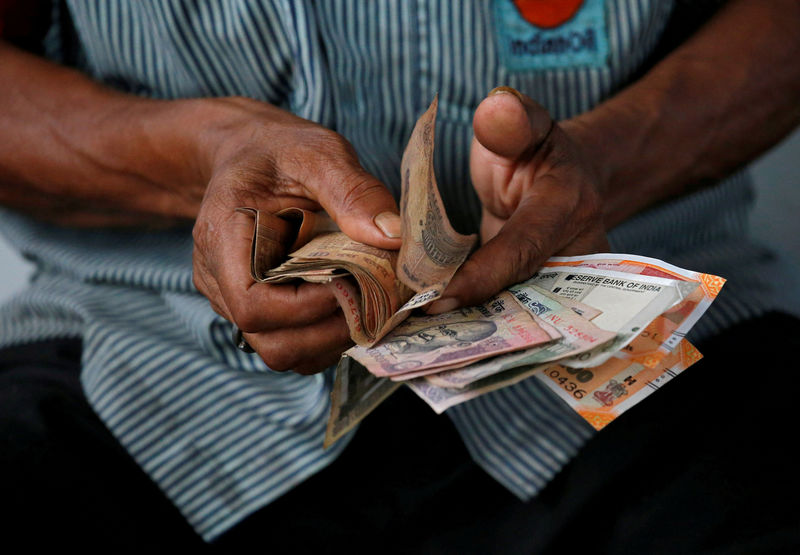 © Reuters. FILE PHOTO: An attendant at a fuel station arranges Indian rupee notes in Kolkata
© Reuters. FILE PHOTO: An attendant at a fuel station arranges Indian rupee notes in KolkataBy Anisha Sheth and Hari Kishan
BENGALURU (Reuters) – The Reserve Bank of India is likely to raise interest rates in early October, despite relatively tame inflation, to prop up a retreating rupee, according to a Reuters poll of economists who also trimmed their near-term growth forecasts.
In an abrupt change from the last survey conducted two months ago, which predicted rates would stay on hold until this quarter next year, two-thirds of 61 economists polled Sept. 19-25 said the RBI would lift the repo rate at least once by year-end.
Slightly over half said RBI Governor Urjit Patel and the Monetary Policy Committee would deliver a 25-basis-point rise to 6.75 percent at the Oct. 4 policy meeting, with one economist calling for a 50-basis-point rise.
The predicted rate hike would be the RBI’s third this year, having lifted borrowing costs in June and August. The U.S. Federal Reserve is forecast to raise rates this week – its third this year – according a separate Reuters poll. [ECILT/US]
For many analysts, the retreating Indian rupee
On Tuesday the rupee, hit recently by growing credit concerns engulfing non-banking financial companies, was trading at 72.68 to the dollar.
The finance ministry also wants RBI to boost liquidity.
“For the RBI, I think it becomes necessary to provide a policy response. The question was only of timing,” said Radhika Rao, economist at DBS in Singapore.
“Some would say it (rate hike) could have come sooner … it probably would have been a bit more beneficial. But better now than never.”
If the RBI does raise rates, it would be the latest in a series of emerging market central banks that have been pressured into tightening policy in response to a tumbling currency.
Fortunately for the RBI, the economy is doing well. The Indian economy is forecast to expand by an annual rate of more than 7 percent every quarter for the next two years, although slower than the surprise 8.2 percent rate clocked last quarter.
This means that India will remain the world’s fastest growing major economy, but economists have chopped forecasts somewhat for coming quarters.
“Although the high growth rate in Q2 might be partly attributed to favorable base effects … the underlying dynamics of the Indian economy shows that virtually all high-frequency data is flashing green,” said Hugo Erken, senior economist at Rabobank.
Prices of () – the country’s biggest import – have surged by over 20 percent this year. That in turn has swollen the current account gap to 1.9 percent of GDP, swinging to deficit from a small surplus of 0.7 percent a year ago.
That gap is forecast to widen further to 2.8 percent of GDP by the fiscal year ending in March 2019, before easing slightly to 2.5 percent in 2019-20.
Just over half of 49 respondents who answered an additional question said the biggest economic risk over the coming year was higher fuel prices.
The escalating U.S.-China trade war has not had a major impact on India so far but has spurred on a broad selloff in emerging market assets since the beginning of this year.
The sharp fall in the rupee has not stirred much worry about inflation, however, which was just under 3.7 percent in August, slightly below the 4 percent where the RBI prefers it to be.
It is expected to average 4.1 percent this quarter and next, but rise to 5 percent by the middle of 2019 – significantly lower than the predictions in the last poll two months ago.
Economists were almost evenly split on whether a weaker rupee posed the biggest upside risk to inflation, with 26 of 51 respondents saying it was.
But even if the RBI raises rates on Oct. 4, it will still struggle to keep up with the Fed, which is expected to keep tighten policy well into next year.
“The RBI will have to do more, though that looks unlikely on the grounds of on-target inflation and stress in the financial sector,” Prakash Sakpal, Asia economist at ING, wrote in a research note.
(For a graphic on ‘biggest downside risk to the Indian economy’ click https://tmsnrt.rs/2xB8sNF)
Source: Investing.com



























